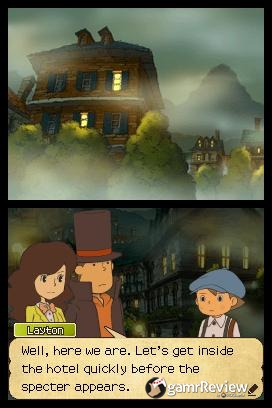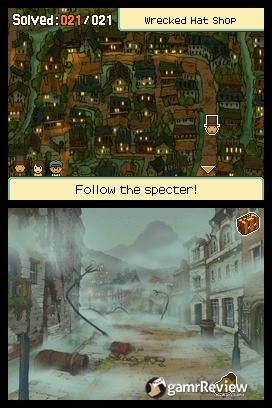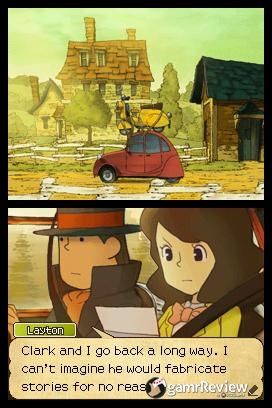Existing User Log In
New User Registration
Register for a free account to gain full access to the VGChartz Network and join our thriving community.





America - Front


America - Back

It’s tough being the sequel to follow hot on the heels of the masterpiece that was Professor Layton and the Unwound Future. In fact, as most followers of the series know, The Unwound Future was at one point in time considered to be the closing chapter of Layton’s saga. However, in our modern world, economic success can make it very hard to lay a franchise to rest, even after the original story has been told (I’m looking your way, George Lucas). So, just as with Star Wars, another chapter in the Layton saga was very much inevitable, and Professor Layton and the last Specter is the first part of a brand new story arc. Being the first entry of what will eventually become a second trilogy, there are quite a few noticeable changes in the setting and overall plot, but rest easy, the main dynamic duo of Dr. Layton and Luke return to guide us through this bold new set of adventures. In order to better lay the foundations for the new story arc, the developers decided to revisit a previously unseen early adventure in the Professor’s past and treat us to the origins of the good Professor’s friendship with Luke, as well as an early encounter with the villain of the series. So, yes… it’s a prequel! (I know, I know, the similarities are starting to pile up).
Being the first entry of what will eventually become a second trilogy, there are quite a few noticeable changes in the setting and overall plot, but rest easy, the main dynamic duo of Dr. Layton and Luke return to guide us through this bold new set of adventures. In order to better lay the foundations for the new story arc, the developers decided to revisit a previously unseen early adventure in the Professor’s past and treat us to the origins of the good Professor’s friendship with Luke, as well as an early encounter with the villain of the series. So, yes… it’s a prequel! (I know, I know, the similarities are starting to pile up).
The story, as usual, starts with a letter. Clark Triton, an old friend and colleague of Layton sends a letter of distress, requesting the help of the Professor to unravel the mystery of the Specter, a mythical ghostly entity that was rumored to have long ago protected the town of Misthallery (where Dr. Triton is currently the major), but which has now apparently returned intent on destroying it. The Professor, who is aware that an excavation to find the ruins of the ancient Golden Garden on the outskirts of Misthallery started more or less at the same time as the Specter’s vengeful return, suspects a connection and promptly decides to go to his friend’s aid and investigate. En route, he is joined by Emmy Altava, his new assistant at the university. Once in Misthallery, Clark’s young son Luke offers to guide them through the town. And so, the trio embark on a new adventure filled with puzzles, legendary creatures, shadowy organizations, and a new nemesis up to no good.
The Last Specter works out as a 'Layton: Year One' kind of tale, showing us the Professor in his earlier days (that is, before he became a renowned archeologist and Scotland Yard collaborator). Luke, his future sidekick, is depicted as being somewhat younger than in previous adventures, and is visibly shier and more insecure. Perhaps the most shocking aspect of The Last Specter is that there is a visible shift in the lineup of recurring support characters. Inspector Chelmey only appears in passing, and is largely replaced by Inspector Grosky in the role of Scotland Yard’s field investigator. Granny Riddleton also appears only briefly and her role in the game is soon taken over by the least expected of possible replacements. The malevolent Don Paolo is nowhere in sight; apparently in Layton’s universe there is space for more than one criminal mastermind. However, by far the most prominent new arrival is Emmy, the professor’s new assistant, and the de facto replacement for Flora as the female member of Layton’s entourage. Professor Layton and the Last Specter follows most of the conventions one has come to associate with a Layton title: the game is played using the stylus on the bottom screen; you have to solve a series of puzzles to keep the story going; puzzles have no time limits; and there is a kind of valuation system, where each puzzle has a value in 'picarats' which decreases with each incorrect answer. In order to help you navigate through the tougher riddles you can collect hint coins that are hidden around town and which can be used to buy hints to solve each puzzle, at the rate of one hint coin per normal hint and two coins for the final super-hint that almost gives away the solution entirely. The puzzles themselves seem to continue the trend, which began in The Unwound Future, of being easier overall but more tiered, so they become progressively more difficult as you progress. There are also items hidden throughout the town, three mini-games in the Professor’s trunk to play, and an additional mini-game in Misthalery proper.
Professor Layton and the Last Specter follows most of the conventions one has come to associate with a Layton title: the game is played using the stylus on the bottom screen; you have to solve a series of puzzles to keep the story going; puzzles have no time limits; and there is a kind of valuation system, where each puzzle has a value in 'picarats' which decreases with each incorrect answer. In order to help you navigate through the tougher riddles you can collect hint coins that are hidden around town and which can be used to buy hints to solve each puzzle, at the rate of one hint coin per normal hint and two coins for the final super-hint that almost gives away the solution entirely. The puzzles themselves seem to continue the trend, which began in The Unwound Future, of being easier overall but more tiered, so they become progressively more difficult as you progress. There are also items hidden throughout the town, three mini-games in the Professor’s trunk to play, and an additional mini-game in Misthalery proper.
The most notable addition to the game is the London Life Simulation that comes along with the game. This addition is not a mini-game per se, but more like an Animal Crossing-type simulation of Professor Layton’s universe which plays out separately from the main game. It’s an interesting concept that adds new life to the game, and it offers for the first time a very limited degree of multi-player interaction. Full of potential, it’s likely to stick around in some form or another in future releases. Another interesting addition are the Episodes, which are small passages of the story that are not included in the main narrative and which can be unlocked and viewed separately after solving certain puzzles.
The slightly surrealistic and delightful art style that's charmed many in the past is back and in good form. Misthalery is easily one of the more colorful towns we have seen so far in the series, with a varied topography that includes canals, both middle and upper class neighborhoods, a market, a factory, an excavation site, a mountain lake, and many other elements. The game is rife with small cinematic clips at every critical point, and each of these is such a visual treasure that I only regret you can’t replay them at will. Both the main game and the cinematics run flawlessly, carrying the story with elegance from one puzzle to the next. The voice acting is as wonderful as ever and is coupled with a superb musical accompaniment and pleasant ambient sound effects, which combine to further immerse you in events. There are a few things, however, that can be criticized in Professor Layton and the Last Specter. The story, for instance, works well as an upbeat tale of adventure and mystery, but lacks much of the emotional depth of previous Layton games. The few times it does try to engage us emotionally it often misses, bordering dangerously close to the edge of cheesiness. A couple of the puzzles, even after being properly solved, wind up with more than one possible outcome, forcing you to guess the last step, which goes against the spirit of a true brainteaser. Finally, there are several issues regarding the Emmy character. Although a likable addition to the Layton universe, it seems the creators pushed a little too hard to establish her and ended up weakening the persona of the main protagonist. For example, there is one passage in the game were Layton, Luke, and Emmy are ambushed by a group of thugs. Nothing special - we’ve seen that before - but this time instead of the Professor stepping up to the plate, he falls back and meekly stands behind Luke while Emmy singlehandedly confronts them all. If that is not a violation of the Professor’s Code of the Top Hat Gentleman I don’t know what is. Sadly, this is one of just many examples.
There are a few things, however, that can be criticized in Professor Layton and the Last Specter. The story, for instance, works well as an upbeat tale of adventure and mystery, but lacks much of the emotional depth of previous Layton games. The few times it does try to engage us emotionally it often misses, bordering dangerously close to the edge of cheesiness. A couple of the puzzles, even after being properly solved, wind up with more than one possible outcome, forcing you to guess the last step, which goes against the spirit of a true brainteaser. Finally, there are several issues regarding the Emmy character. Although a likable addition to the Layton universe, it seems the creators pushed a little too hard to establish her and ended up weakening the persona of the main protagonist. For example, there is one passage in the game were Layton, Luke, and Emmy are ambushed by a group of thugs. Nothing special - we’ve seen that before - but this time instead of the Professor stepping up to the plate, he falls back and meekly stands behind Luke while Emmy singlehandedly confronts them all. If that is not a violation of the Professor’s Code of the Top Hat Gentleman I don’t know what is. Sadly, this is one of just many examples.
The main storyline of the game can be completed in just under 20 hours, although there's potential for more if you try to solve all of the puzzles and collect all of the items available. There is little replay potential in the main game, but the mini-games and the London Life simulation round out the package nicely, making this the Layton release with the largest overall replay value. And, as with all Layton games, the story works perfectly both as a sequel and a standalone title, so it’s equally enjoyable for both new arrivals and long-time followers of the series.
Professor Layton and the Last Specter marks a turning point in the franchise and is a game that fans of his adventures really don’t want to miss. Despite the criticisms made above, this is still a remarkably polished and enjoyable game, endowed with a captivating storyline, interesting new characters, plenty of back story, and almost 200 challenging and fulfilling puzzles. If it had been the first release in the series there wouldn't have been much to criticise, as many of the game’s woes stem from it following on from The Unwound Future, so I’m sure you’ll very much still enjoy the ride.










|
|
OneTwoThree
posted 28/12/2011, 01:16
@Salnax: It's not surprising, this series is astonishingly conservative. I've played the first 3 games, and gameplay-wise they're identical. While the respective stories got worse, from 1 (surprising and immersive), to 2 (moving, if a bit far-fetched) to 3 (absurd and ridiculous). Message | Report |
|
|
Soulblazer
posted 23/12/2011, 12:05
damn those are some very impressive european sales Message | Report |
|
|
enrageorange
posted 22/12/2011, 08:33
this is tracking ridiculously ahead of unnwound future in europe. Can't see sales dropping next week considering its christmas. It has a very good shot at passing unwound future. Also these sales are still huge. I'm sure level 4 is more then happy with sales as long as they remain above 1mil, let alone 2mil. Message | Report |
|
|
Salnax
posted 20/12/2011, 03:55
Despite the great European sales, the trend is clear. Every Layton game has done worse than its predecessor. After the second trilogy and Ace Attorney crossover are finished, it might be time for the series to either take a break or reinvent itself, possibly for the eShop and other downloadable services. Message | Report |
|
|
|
|
|
|